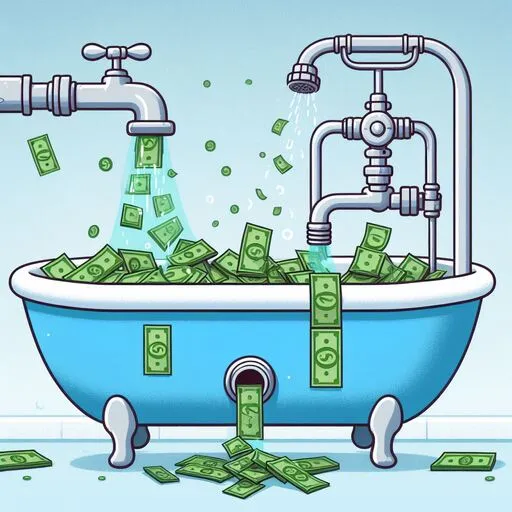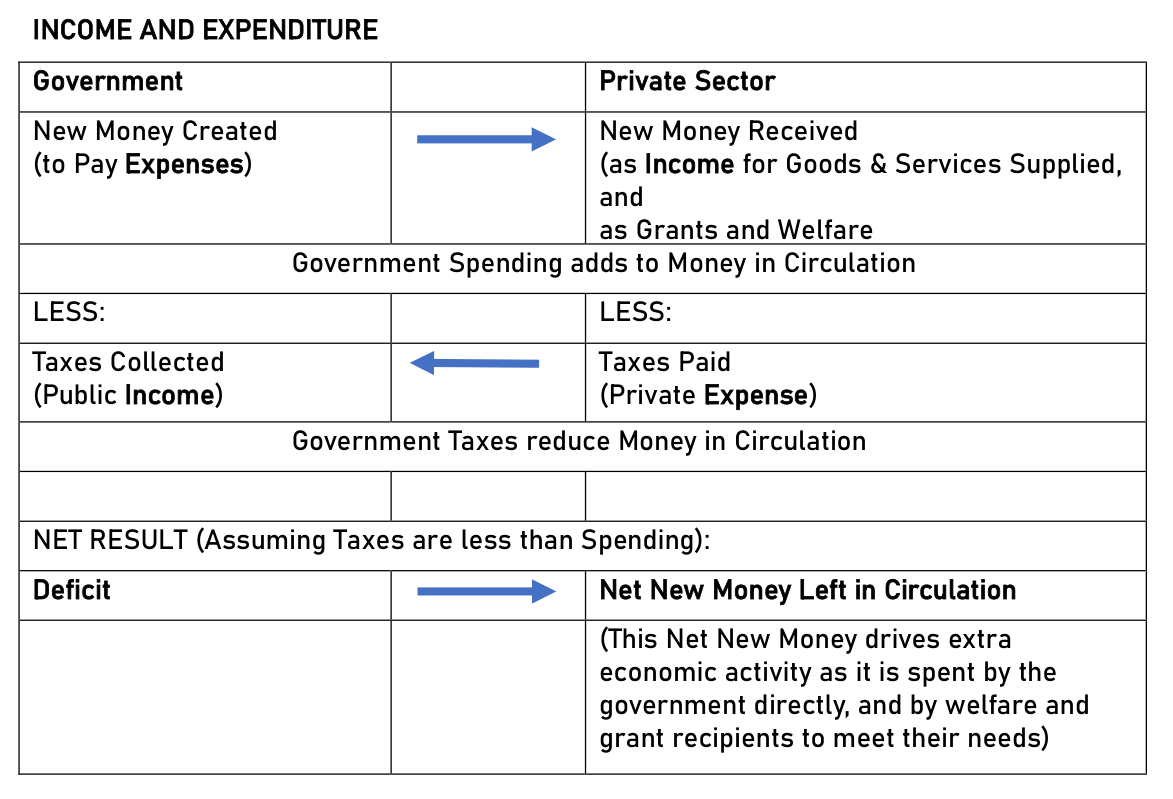Modern Monetary Theory is NOT a Theory. It’s How The System Works.
Michael Haines | Sat Mar 23 2024

What Economics Has Got Wrong
Most economists still seem to think that money is merely a ‘means of exchange’, ‘store of wealth’, or ‘unit of account’, ignoring the fact that newly created money shifts economic activity to meet the needs of those to whom it is allocated. Which means who gets how much of the new cash is of critical importance in determining well-being… and production. The problem is compounded by an apparent lack of understanding about how the system really works: how money is created, allocated and destroyed.
Correcting The Misconception
Prof. Stephanie Kelton, in her book ‘The Deficit Myth’, along with other writings (and increasingly other economists), has been attempting to address this failure through the promotion of ‘Modern Monetary Theory’ (MMT). Which is poorly named, as it is not a theory at all. It simply describes how the monetary system works. It would be better named the ‘Modern Monetary System’.
A new film featuring Prof. Kelton, called ‘Finding the Money’, offers a clear explanation of the money system, as well as a devastating critique of global economists who clearly have no idea how the system works, as they try to explain how they think that it does!
Everyone should see it when it comes out on general release.
How Money is Really Created, Allocated, and Destroyed
The basic premise of MMT is that all money is created ‘out of thin air’. Some by Government, and some by banks… via a computer entry.
The money created by Government finds its way into the economy as it is spent to provide public goods and services, and to fund grants and welfare. Taxes merely claw-back some, as a means of reducing the total amount of money in circulation, to protect against inflation.
Money is also created by banks, as they make loans, and is destroyed as the loans are repaid and the entries in the bank’s books are reversed.
Specifically, the bank makes two entries on its Balance Sheet: Debit Loan and Credit Deposit in the same name. The double entry keeps the bank’s books in balance, while the debit records the amount to be repaid by the borrower, and the credit records the amount of ‘cash’ the borrower can draw down.
In fact, cash is rarely taken out. Often, the borrower simply instructs the bank to ‘pay’ another party. In this case, no money goes to the payee’s bank. Just a message telling the payee’s bank to add to the payee’s bank account the amount specified by the borrower. At the same time, the borrower’s bank reduces the borrower’s deposit by the same amount. The payment also gives rise to a matching inter-bank debt that is settled via the Central Bank. It’s all done on computer.
Where cash is taken, the deposit is simply reduced by the amount of cash. Printing or the issue of notes (or coins) does not create money. It simply changes the form of money from a computer entry into cash.
The new money is then spent into the economy to meet the needs of the borrowers, further driving new economic activity.
This is the reverse of how most economists and textbooks describe it.
The Misconception and Where it Leads
Most people seem to believe that spending can only occur if Governments first raise taxes, and banks first raise deposits — because it just makes sense on a personal level, and it’s what most economists tell us. But it is not true.
This misconception leads to unnecessary angst over ‘Government Debt’, illustrated most recently by Republican Senator Mitt Romney damning US President Biden because he did not mention in his SOTU speech the ballooning US$34 Trillion Debt “that is going to burden our children and grandchildren”.
Similarly, on 8 February 2024, Elizabeth Schulze wrote on US ABC News web site that “The federal government’s record-high national debt is set to get even bigger, reaching a massive $54 trillion by the year 2034”. With Maya MacGuineas, president of the Committee for a Responsible Federal Budget, saying in a statement to ABC News:”Our debt is rising out of control, and it’s time for Congress to wake up,”
There are even ‘Debt Clocks’ that show the constantly increasing amount of Federal Debt, as well as the ‘share’ of the debt that each citizen ‘owes’… just to scare us!
We hear similar messages from politicians in every country, including Australia.
The Truth
A country with a sovereign currency (like the US or Australia) can always pay its debts in that currency, ‘at the press of a button’. Unfortunately, this gives the erroneous impression that paying debt in this way would result in massive inflation, and/or destroy the exchange rate. It does not.
While ‘Finding the Money’ provides a clear explanation of the money system, it could benefit from a summary in accounting terms, as there are always two sides to any transaction. For every expense there is an income; and for every debt, there is an asset.
Accounting for the Money Flows
The following diagram is not a ‘strict accounting ledger’, as it combines both the Government and Private sector in two columns. It builds on the approach outlined by Prof. Kelton to illustrate the impact of the new money flows on the Profit and Loss and the Balance Sheets of both the Government and the Private sector. See table below (author’s diagram).


The Deficit Myth (with acknowledgements to Stephanie Kelton)
As illustrated, all the focus on the Government ‘Debt Clock’ (the money owed on bonds) fails to recognise that it is matched by the Private Sector ‘Asset Clock’.
It also fails to recognise that, as a result of selling the bonds, the Government retains the cash it receives. This cash can sit on its Balance Sheet until the time comes to repay the bonds. Repayment is therefore never in doubt. The entries are simply reversed: the cash goes down along with the liability for the bonds (as they are repaid). There is zero change in the Government’s net asset position.
If in the next year, the Government continues to run a deficit, it again adds to the money supply, without any change in the level of debt. The debt only goes up if the Government sells bonds to take some money out of the economy. Again, receiving cash that it can hold against repayment upon maturity.
This should eliminate any concern that ‘future generations’ will have to make any sacrifice to repay ‘our’ debts.
Nor does Government borrowing ‘crowd out’ private sector borrowing. A private individual or corporation is always able to go to a bank and get a loan based on their own creditworthiness and interest rates at the time. The bank does not have to find the money to make the loan. Like the Government, it just makes the necessary entries in its books: Debit Loan and Credit Deposit. Money at the stroke of a few keys.
The level of Government Debt has no bearing at all on interest rates. This is clear from the 40-year climb in debt, matched by a 40-year fall in interest rates since the 1980’s. This could not occur if Government Borrowing ‘crowded out’ Private Borrowing.
In fact, there is no need to issue bonds at all, except to provide a guaranteed income for the bond holders, who would otherwise have to hold their cash or invest it elsewhere.
The money to pay the interest does not need to come out of tax. It can be created, just the same as for all Government spending. While this new money also feeds into the economy, most gets reinvested, so it has little impact on the demand for goods and services, and hence inflation in consumer prices.
The Surplus Myth (also with acknowledgements to Stephanie Kelton)
The complementary erroneous idea to ‘The Deficit Myth’, is that a surplus is required to ‘bank savings’ — to ‘pay for a future deficit’. Yet, as the accounts show, a surplus is not ‘banked’. A surplus is just the opposite of a deficit. It takes money out of the economy, reducing private wealth , and current economic activity. That is all. If the economy is overheating, and needs to be calmed, there are a whole host of factors to be considered. Merely putting the Government into surplus does not address them.
Utilizing Our Resources for the Common Good
In recognizing that Federal Debt is not a problem, we can look at each year’s spending with a fresh eye. We can consider what are the main priorities to advance community well being: health, education, housing, etc and consider the resources available to deliver ongoing improvement. If housing for the homeless is critical, but the private construction sector is already stretched, perhaps there is a need to consider temporary solutions (say, using hotels that may be under-utilized) until private demand softens, or incentives could be provided to build more social housing and fewer upmarket homes. Whatever the decisions made, they should be based on the availability of resources, not the level of debt, or even the level of the deficit.
Managing Economic Downturns
This understanding of the money system also allows us to ignore any accumulated debt and to expand the deficit as needed to return the economy to full capacity in the event of a downturn. This raises the prospect of a ‘Job Guarantee’ for those who can do paid work, as well as a ‘Basic Income’ set to keep the labour market in ‘dynamic balance’. The fairest and most effective way to underpin all people (not just those able to do paid work) is to pay individuals an equal amount of ‘new money’, so they can spend it to meet their needs. As they spend, the new money will generate new demand, drawing idle resources back into production, restoring the economy to full capacity — benefiting the people who spend the money, as well as the businesses where it is spent. But both Job Guarantees and a Basic Income are topics for another day.
Managing Inflation
If inflation does become a concern, a decision then has to be made: to cut back government spending, and/or bank lending, and/or to raise taxes, and in what areas. That said, inflation should never be a reason to cut back payments that people rely on to survive. Indeed, MMT shows that the real value of these can be maintained, and so should be maintained. But that’s also a whole other discussion.